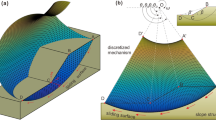Abstract
A three-dimensional (3D) seepage-flow numerical simulation model was developed for seepage analysis of a landslide dam. A 3D seepage-flow numerical simulation model coupled with a two-dimensional (2D) surface flow and erosion/deposition model was developed for seepage analysis of a slope due to a rainfall event. The conventional water-phase (one-phase) seepage-flow model assumed only water-phase flow in seepage analysis, which was inadequate for unsaturated soil domains. A water-air two-phase seepage-flow model that considers both the water and air phases in the seepage-flow process was also used for the seepage analysis. The pore-water pressure and moisture-content data obtained from the seepage-flow model were used to analyze the stability. Janbu’s simplified method and the extended Spencer method were used for the stability analysis. The numerical simulation results almost compared well with laboratory experimental measurements.
Similar content being viewed by others
References
Awal, R., Nakagawa, H., Kawaike, K., Baba, Y., and Zhang, H. (2008). “An integrated approach to predict outflow hydrograph due to landslide dam failure by overtopping and sliding.” Annual Journal of Hydraulic Engineering, JSCE, Vol. 52, pp. 151–156.
Awal, R., Nakagawa, H., Kawaike, K., Baba, Y., and Zhang, H. (2009). “Three dimensional transient seepage and slope stability analysis of landslide dam.” Annuals of Disaster Prevention Research Institute, Kyoto University, No. 52B, pp. 689–696.
Chen, J., Hopmans, J. W., and Grismer, M. E. (1999). “Parameter estimation of two-fluid capillary pressure-saturation and permeability functions.” Advances in Water Resources, Vol. 22, No. 5, pp. 479–493.
Crozier, M. J. (1999). “Prediction of rainfall-triggered landslides: A test of the antecedent water status model.” Earth Surface Processes and Landforms, Vol. 24, No. 9, pp. 825–833.
Dakshanamurthy, V., Fredlund, D. G., and Rahardjo, H. (1984). “Coupled three dimensional consolidation theory of unsaturated porous media.” Proceedings of the Fifth International Conference on Expansive Soils, Adelaide, South Australia.
Davies, T. R., Manville, V., Kunz, M., and Donadini, L. (2007). “Modeling landslide dambreak flood magnitudes: Case study.” Journal of Hydraulic Engineering, Vol. 133, No. 7, pp. 713–720.
Fredlund, D. G., Morgenstern, N. R., and Widger, R. A. (1978). “The shear strength of unsaturated soils.” Canadian Geotechnical Journal, Vol. 15, No. 3, pp. 313–321.
Freeze, R. A. (1978). “Mathematical models of hillslope hydrology.” Hillslope Hydrology, John Wiley, pp. 177–225.
Fukuzono, T. (1987). “Experimental study of slope failure caused by heavy rainfall.” Erosion and Sedimentation in the Pacific Rim, Proceedings of the Corvallis Symposium, Oregon, USA.
Jiang, J. C. and Yamagami, T. (2004). “Three-dimensional slope stability analysis using an extended spencer method.” Soils and Foundations, Japanese Geotechnical Society, Vol. 44, No. 4, pp. 127–135.
Mizuyama, T., Satofuka, Y., Ogawa, K., and Mori, T. (2006). “Estimating the outflow discharge rate from landslide dam outbursts.” Proceedings of the INTERPRAEVENT International Symposium on Disaster Mitigation of Debris Flows, Slope Failures and Landslides, Vol. 1, No. 2, pp. 365–377.
Mukhlisin, M. and Taha, M. R. (2009). “Slope stability analysis of a weathered granitic hillslope as effects of soil thickness.” European Journal of Scientific Research, Vol. 30, No. 1, pp. 36–44.
Nakagawa, H. (1989). Study on risk evaluation of flood and sediment inundation disaster, PhD Thesis, Kyoto University (in Japanese).
Nakagawa, H., Takahashi, T., Satofuka, Y., and Kawaike, K. (2003). “Numerical simulation of sediment disasters caused by heavy rainfall in Camuri Grande basin.” Proceedings of the Third Conference on Debris-Flow Hazards Mitigation: Mechanics, Prediction, and Assessment, Switzerland, Rotterdam, Venezuela 1999, pp. 671–682.
Sassa, K. (1972). “Analysis on slope stability: I, Mainly on the basis of the indoor experiments using the standard sand produced in Toyoura.” Journal of the Japan Society of Erosion Control Engineering, Vol. 25, No. 2, pp. 5–17 (in Japanese with English abstract).
Sassa, K. (1974). “Analysis on slope stability: II, Mainly on the basis of the indoor experiments using the standard sand produced in Toyoura, Japan.” Journal of the Japan Society of Erosion Control Engineering, Vol. 26, No. 3, pp. 8–19 (in Japanese with English abstract).
Satofuka, Y., Mori, T., Mizuyama, T., Ogawa, K., and Yoshino, K. (2010). “Prediction of floods caused by landslide dam collapse.” Journal of Disaster Research, Vol. 5, No. 3, pp. 288–295.
Sharma, R. H. (2006). Study on integrated modeling of rainfall induced sediment hazards, PhD Thesis, Kyoto University, Japan.
Takahashi, T. (1991). Debris flow, Monograph Series of IAHR, Balkema, pp. 1–165.
Takahashi, T. and Kuang, S. F. (1988). “Hydrograph prediction of debris flow due to failure of landslide dam, Annuals Disaster Prevention Research Institute.” Kyoto Univ., No. 31, B-2, pp. 601–615.
Takahashi, T. and Nakagawa, H. (1994). “Flood/debris flow hydrograph due to collapse of natural dam by overtopping.” Journal of Hydroscience and Hydraulic Engineering, JSCE, Vol. 12, No. 2, pp. 41–49.
Touma, J. and Vauclin, M. (1986). “Experimental and numerical analysis of two-phase infiltration in a partially saturated soil.” Transport in Porous Media, Vol. 1, No. 1, pp. 27–55.
Tsai, T. L., Chen, H. E., and Yang, J. C. (2008). “Numerical modeling of rainstorm-induced shallow landslides in saturated and unsaturated soils.” Environmental Geology, Vol. 55, No. 6, pp. 1269–1277.
Tsutsumi, D. and Fujita, M. (2008). “Relative importance of slope material properties and timing of rain fall for the occurance of landslides.” International Journal of Erosion Control Engineering, Vol. 1, No. 2. pp. 79–89.
Van Genuchten, M. T. (1980). “A closed-form equation for predicting the hydraulic conductivity of unsaturated soils.” Soil Science Society of America Journal, Vol. 44, No. 5, pp. 892–898.
Author information
Authors and Affiliations
Corresponding author
Rights and permissions
About this article
Cite this article
Regmi, R.K., Lee, G. & Jung, K. Analysis on failure of slope and landslide dam. KSCE J Civ Eng 17, 1166–1178 (2013). https://doi.org/10.1007/s12205-013-0049-y
Received:
Accepted:
Published:
Issue Date:
DOI: https://doi.org/10.1007/s12205-013-0049-y




